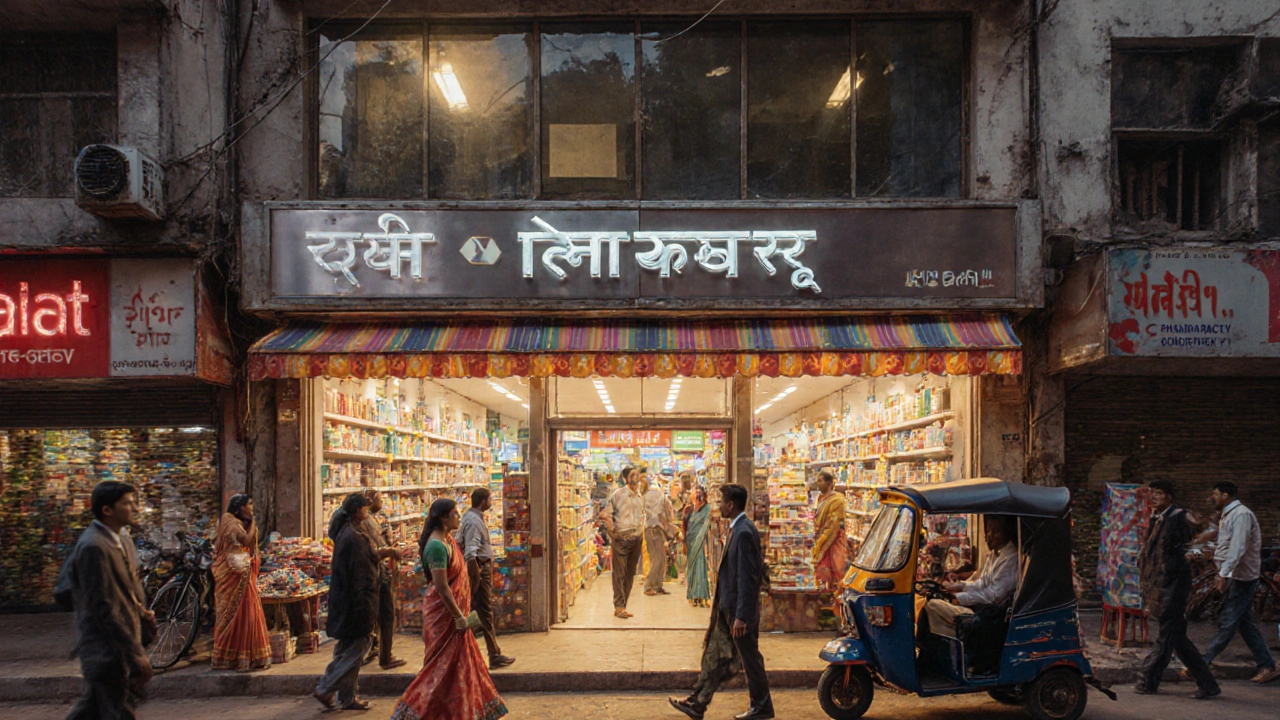Pharmacy Startup Cost in India: Detailed Breakdown 2025

Pharmacy Startup Cost Estimator
Quick Takeaway
- Initial investment ranges from INR 15 lakh to INR 45 lakh, depending on location and scale.
- Key cost buckets: licensing (INR 1-5 lakh), rent (INR 2-12 lakh/yr), inventory (INR 5-15 lakh), staff salaries (INR 3-8 lakh/yr).
- Choose a Private Limited or LLP to limit personal liability and ease financing.
- Compliance with the State Pharmacy Council and CDSCO is mandatory before opening.
- Invest in pharmacy management software to streamline inventory and sales.
Understanding the Regulatory Landscape
Before you spend a rupee, you need to know who sets the rules. The State Pharmacy Council is the statutory body that issues the retail drug license in each Indian state and ensures that pharmacies follow the Drugs and Cosmetics Act. On the national level, the Central Drugs Standard Control Organization (CDSCO) regulates drug standards, import‑export, and clinical trials across India. Both entities must sign off before you can legally sell medicines.
The licensing process typically involves:
- Submitting an application with a site plan and qualified pharmacist details.
- Paying the fee, which varies by state (INR 1-5 lakh).
- Undergoing an on‑site inspection.
- Receiving the registration certificate, valid for 5 years, after which you’ll need to renew.
Skipping this step isn’t an option - non‑compliance can lead to fines, seizure of stock, or closure.
Capital Requirements Overview
Opening a pharmacy is a capital‑intensive venture, but the exact number depends on three main factors:
- Location tier: Tier‑1 metros (Mumbai, Delhi) demand higher rent and inventory.
- Business model: Stand‑alone retail vs. franchise vs. online‑plus‑store.
- Service scope: General medicine shop versus a full‑service clinical pharmacy with diagnostic services.
Below is a typical range for a 1000‑sq‑ft retail outlet, which is a common footprint for a first‑time pharmacy.
| Component | Estimated Range | Key Notes |
|---|---|---|
| Drug License & Registration | 1,00,000 - 5,00,000 | State‑dependent; includes inspection fees. |
| Rent (first year) | 2,00,000 - 12,00,000 | Higher in Tier‑1 cities; negotiate security deposit. |
| Interior Fit‑out & Shelving | 3,00,000 - 7,00,000 | Cold storage, security systems, counters. |
| Initial Inventory (Medicines) | 5,00,000 - 15,00,000 | Broad‑spectrum generic list; include OTCs. |
| Pharmacy Management Software | 50,000 - 2,00,000 | Cloud‑based, barcode scanning, sales analytics. |
| Staff Salaries (first 6 months) | 3,00,000 - 8,00,000 | Qualified pharmacist, assistant, cashier. |
| Legal & Incorporation Fees | 1,00,000 - 2,50,000 | LLP or Private Ltd registration. |
| Working Capital Reserve | 3,00,000 - 5,00,000 | Cushion for cash‑flow gaps. |
The total comes out to roughly INR 15 lakh for a modest setup in a Tier‑2 city, and up to INR 45 lakh for a premium outlet in a Tier‑1 metro.

Step‑by‑Step Launch Process
Now that you’ve got the numbers, here’s how to turn the plan into reality.
- Choose the legal structure. Register as a Private Limited Company or Limited Liability Partnership. The Business Entity limits personal liability and makes it easier to secure bank financing later.
- Secure financing. Approach banks, NBFCs, or angel investors. Most lenders ask for a detailed business plan and a minimum 20% down‑payment.
- Find a location. Look for high footfall areas near clinics, hospitals, or residential complexes. Verify that the premises complies with the fire‑safety and zoning norms.
- Obtain the drug license. Submit the application to the State Pharmacy Council, attach the site layout, qualified pharmacist’s degree, and pay the fee.
- Fit out the interior. Install temperature‑controlled cabinets, security CCTV, and a POS counter. Remember to allocate space for a small counseling area if you plan to offer medication advice.
- Purchase inventory. Start with a core generic list covering antibiotics, antihypertensives, analgesics, and OTC products. Use a reputable distributor who offers credit terms.
- Implement pharmacy management software. Choose a cloud‑based system that integrates inventory, sales, and expiry tracking. This reduces manual errors and helps with regulatory reporting.
- Hire qualified staff. At minimum you need a registered pharmacist (per the Drugs and Cosmetics Act) and a sales assistant. Offer a basic training on software and customer service.
- Launch marketing. Offer a grand‑opening discount, run health‑check camps, and join local doctor networks for referrals.
- Monitor cash flow. Keep a close eye on inventory turnover and payment cycles. Adjust reorder quantities to avoid over‑stocking expensive brands.
Following these steps reduces the risk of costly oversights and keeps you compliant.
Pre‑Opening Checklist
Print this out or keep it on your phone. Tick each item before you flip the sign.
- Business Entity registration certificate.
- Drug License approved by State Pharmacy Council.
- Lease agreement with clear break‑clause.
- Fit‑out completed, including temperature control units.
- Initial inventory stocked, with supplier credit note.
- Pharmacy Management Software installed and staff trained.
- Qualified pharmacist on payroll with valid registration.
- Fire safety certificate and insurance policy.
- Marketing plan ready - flyers, social media, local partnerships.
- Working capital reserve transferred to operating account.
Common Pitfalls and Pro Tips
Even seasoned entrepreneurs stumble. Here’s what to watch out for:
- Under‑estimating inventory costs. Medicines have a high turnover, but expiry dates are strict. Use a computerized expiry alert system.
- Skipping the reserve fund. A sudden spike in supplier prices or a slow first month can drain cash. Keep at least three months of operating expenses on hand.
- Ignoring local competition. Conduct a SWOT analysis of nearby pharmacies. Differentiate with services like blood pressure checks or home delivery.
- Non‑compliance with labeling. The CDSCO requires batch numbers and manufacturing dates on every sale receipt. Your software should auto‑populate this.
- Hiring unregistered staff. The law mandates a licensed pharmacist present during business hours. Failure can lead to license suspension.
Pro tip: partner with a reputable distributor that offers a “return‑expired‑stock” policy. It protects you from loss if you mis‑forecast demand.

Mini FAQ
What is the minimum capital required to start a pharmacy in India?
For a basic 1000‑sq‑ft outlet in a Tier‑2 city, you can launch with around INR 15 lakh. In Tier‑1 metros, the floor rises to INR 30‑45 lakh due to higher rent and inventory needs.
How long does it take to obtain a drug license?
Typically 45‑60 days, provided all documents are in order and the on‑site inspection passes without issues.
Should I register as a Private Ltd or an LLP?
Both limit personal liability, but an LLP offers easier compliance for small partners, while a Private Ltd may be viewed more favorably by banks for larger loan amounts.
Do I need to hire a qualified pharmacist from day one?
Yes. The Drugs and Cosmetics Act mandates a registered pharmacist to be present during all operating hours. Failure to comply can result in license cancellation.
Can I start with a limited inventory and grow later?
You can begin with a core generic list, but regulators expect a minimum stock of essential medicines. Starting too small may affect patient trust and sales volume.
Armed with these numbers and steps, you can decide whether the financial commitment aligns with your goals. Remember, the pharmacy startup cost India isn’t just a figure - it’s a roadmap to a sustainable health‑care business.